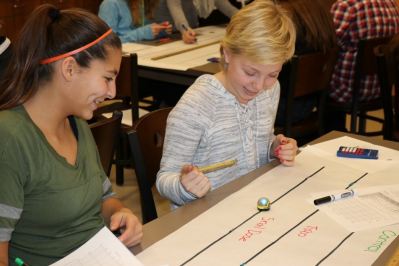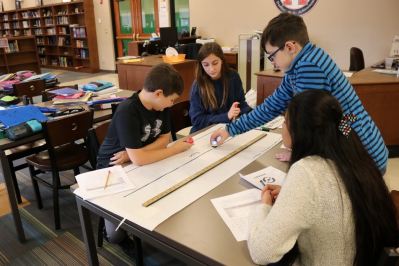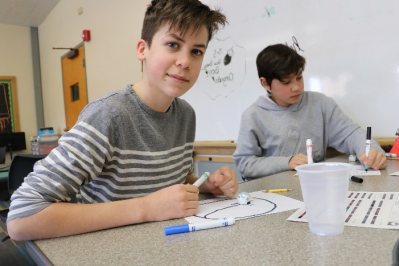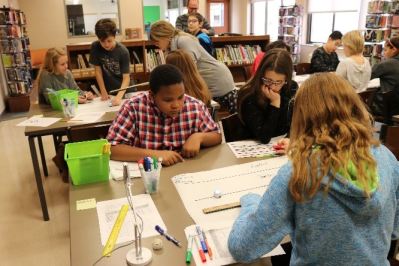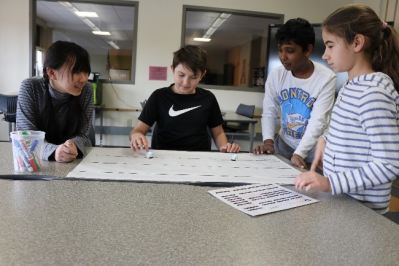Amherst Middle School - Interdisciplinary Computer Science and Physics Lessons
By Lori Sosenko, Communications Analyst, Erie 1 BOCES/Amherst Central School District, LSosenko@amherstschools.org
Located outside of Buffalo, Amherst Central School District is a suburban district with an enrollment of 2,888 students housed at two elementary schools for PreK to Grade 5, one middle school for Grades 6-8 and one high school. In one of these middle school classrooms, the cars, ramps and marbles that had been traditionally used to teach a velocity physics lesson have been packed away. Instead, a robust two-day interdisciplinary lesson in the seventh-grade physics unit had students coding Ozobot mini-robots on three different speed “maps” to gather, calculate, plot and analyze velocity data.
Knowing that technology and working with friends makes middle school students perk up in class, two seventh-grade science teachers in the Amherst Central School District completely transformed the hands-on portion of their physics unit on velocity. Partnering with the Library Media Specialist, the interdisciplinary team developed a two-day lesson plan that had the students working in teams to code and then conduct meter-long time trials with Ozobot mini-robots. The new lesson met a specific objective in presenting new learning for Drew Schmidle, library media specialist, and a different objective of deepening and reinforcing learning for the science teachers, Nancy Claxton and Stacey Susi.
Between the two of them, Claxton and Susi have over 38 years with the district teaching science at Amherst Middle School. For several years, they used a traditional method of putting toy cars or marbles on elevated ramps to measure by distance and time for their hands-on velocity component.
Schmidle, who has been with the district nine years as Library Media Specialist, also operates the Innovation Lab at Amherst Middle School. The lab, developed in February 2017, sits at one end of the library. Enclosed within glass windows, it features green screen technology for morning announcements, maker-kits, drones, ozobots, and other digital learning tools intended for developing curriculum extensions with classroom teachers.
The velocity lesson collaboration evolved organically between the three teachers, because Schmidle knew what was taught in the physics unit, and Claxton and Susi knew of the availability of the ozobots and Schmidle’s expertise within the Innovation Lab. Their collaborations often begin with the phrase, “hey, I’ve got an idea.”
The district’s five-year Strategic Plan outlines more formal goals for use of instructional technology. In that area, the district is working toward the goal of extending learning by identifying and implementing academic opportunities that support, enrich and transcend the traditional classroom.
“This lesson created a learning environment with 21st century learning tools. It provided a digital and technological playground for students to further enhance classroom skills and instruction,” Claxton said, who was named to the NYS Master Teachers program in 2017.
Ozobots are tiny robots that love colors and can be controlled by students using pen and paper, tablets or computers. These robots use light sensors in the form of five tiny eyes to detect a colored road map. The eye in the middle reads the code, and the other eyes read the edges of the track.
The new lesson was presented three weeks into a five-week unit on physics. Its development focused on deepening and reinforcing what they learned about motion. The first three weeks of the unit focused on calculating speed, momentum, and acceleration in moving machines, as well as analyzing the effects caused by changing forces or distances, and the ability to investigate applications of Newton’s Laws of Motion.
“The students liked this velocity lesson. Any kind of technology that you can bring to the students peaks their interest. They like to be in the innovation lab working on things,” Susi stated.
“It was definitely a fun way to show calculating speed compared to a ramp and a car or a marble and ruler. Those were okay, but this definitely took us to a completely different level,” Claxton expressed.
Above, left: Two students run a time trial on the snail dose track of their ozobot robot. Above, right: Four students work as a team on their meter-long track. Below, left: Student practices drawing a circle track for the robot to follow. Below, right: Nancy and Andrew work with students in the library.
Day One: Coding Ozomaps
While the students came to this lesson with prior knowledge of ozobots from elementary school, the broad learning goal was to have students create an exact algorithm--or ozomap--for the ozobots to travel, in order to successfully measure velocity the following day during part two of the lesson.
In introducing new material, Schmidle’s lesson objective was to make the connection to a computer language. Students would be expected to perfect the drawing of a guide line and the color codes for the ozobots to follow.
“I was teaching a computer language where it would be precise. If everything is not specific and precise, the ozobots would not run and would not do what you want it to do,” Schmidle emphasized.
The eyes on the ozobots read a colored line to program its actions. A solid black line is the control, and the unit follows the black line at one speed. By inserting colors of red, green or blue to the black line, the speed will vary.
The students worked individually through a free sketch activity on practice sheets to draw a square with lines that an ozobot could successfully read, and use two codes that the ozobot can read within the square. Schmidle posted a sample of successful lines, and through trial and error, the students learned that width, color contrast and ratio of color placement affected the outcome. They could test their lines using the ozobots and then problem-solve.
Next, the students were placed in teams of four. As a team, they had to create three coded lines, each one a meter long. The control line was black. The Turbo line had to use the turbo code twice (black, blue, green, blue, black). The Snail Dose line had to use the snail code twice (black, red, green, blue, black).
“If the kids didn’t make the color codes correct--even the right width, too long, too short, too faint with the marker--then the ozobot would not process the code properly and would not give them the scientific data they would need to complete their time trials the following day,” Schmidle stated.
How well the team drew their lines using the proportional ratio of colors affected their time trial success: “the code would change if the color sequence was not correct or dark enough...or if it was too dark. Students had to be precise,” Susi reinforced.
The lesson was taught to the entire seventh-grade cohort of 225 students. About one-third of each class (2-3 groups) failed the first day when their lines did not work. They had to redo their lines on the second day.
At the end of the lesson, Schmidle talked about how the manufacturing, automotive and warehouse distribution industries use Automated Guided Vehicles (AGV) and how the students’ activity that day was very similar, just on a smaller scale. His Exit Ticket asked students to describe in 2-3 sentences how life could be made easier with AGV.
Day Two: Calculating Velocity of Ozobot
Using their ozomaps, each team performed three timed trials on each line (black, turbo, and snail). They recorded the time to travel one meter in seconds to the nearest tenth on a data table in their Ozobots Physics packet.
Then, they calculated the average of total time for each line to the nearest tenth of a second. They had to calculate for speed using v=d/t and round to the nearest tenth, and calculate the difference between snail dose and turbo speeds. They also had to plot a double line graph of the average speed for snail and turbo speeds.
Using their knowledge about calculating and measuring distance and applying the velocity formula, the students found that some trials were faster than the others because they had more accurate lines drawn. They were also able to describe the trends revealed on their groups’ data table, as well as the plotted variances between the turbo and snail dose times.
Their packet included the following open-ended writing prompts: what is coding? How does the ozobot understand codes? What was the control used for? Was there a difference between snail dose and turbo speeds and explain? Describe the trends of the graph. And finally, an extra credit question asked students to describe AGV and what they could be used for.
Above, left: Four students race two ozobots on different tracks.
The format of the two-day lesson incorporated individual work, practice and rehearsing, revision, problem solving, discussion and group work to allow for various learning styles and audio, visual and tactile learning opportunities. On both days, all three teachers saw the students exhibiting group behaviors that reinforced what they knew, did not know, and needed to work on. As a team, the students gave each other feedback to assess and modify their performance.
“There was good discussion going on, troubleshooting, and talking about how the code wasn’t there,” Schmidle stated, adding that the discussion seemed to keep the students on task if the code did not work.
“The coding itself and drawing these lines, I knew were important, but until we ran the lab I didn’t realize how specific you have to be,” Claxton said. “It’s a challenge. We drew lines ahead of time as samples, played with it ourselves, and quickly saw what did and didn’t work.”
“Based on students’ responses and the data we gathered from it, I think this lesson was successful,” Susi concluded.
Process Reflections
- Teachers should definitely run through the activity and practice creating these codes themselves so they can see how precise it needs to be.
- Make sure that you can see a definite color change on the lines. One trick is to darken the current color just before a new color change. Make sure the contrast is crisp.
- They used Crayola brand markers, and we wondered if the Sharpie brand might have worked differently. With the Crayolas, they could not color the blue in too much and the ozobot read that as black.
- Holding the marker at an angle created a better line. Schmidle demonstrated how to use the side of the marker on Day 1 of the lesson.
“By working together we infused classroom curriculum in a modern technological learning environment,” Susi stated.
“Pooling our experience and strengths results in much better ideas and creativity in how we delivered the lesson. It brought higher level thinking and dimensions to the lesson which can only benefit our students,” Claxton added.
Contact:
- Nancy Claxton, Seventh Grade Science Teacher, Amherst Middle School, nclaxton@amherstschools.org
- Stacey Susi, Seventh Grade Science Teacher, Amherst Middle School, ssusi@amherstschools.org
- Drew Schmidle, Library Media Specialist, Amherst Middle School, aschmidle@amherstschools.org






